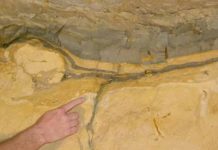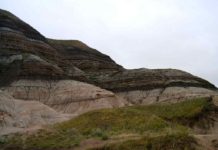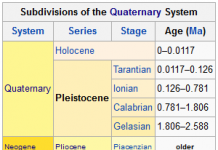The Furongian is the fourth and final series of the Cambrian. It lasted from ~497 to 485.4 ± 1.9 million years ago. It succeeds the still unnamed 3rd series of the Cambrian and precedes the Lower Ordovician Tremadocian stage. It is subdivided into three stages: the Paibian, Jiangshanian and the unnamed 10th stage of the Cambrian.
Naming
The Furongian was also known as the “Series 4” of the Cambrian and replaced the older term “Upper Cambrian” and equivalent to the local term “Hunanian”. The name “Furongian” was ratified by the International Commission on Stratigraphy in 2003. Furong (芙蓉) means “lotus” in Chinese and refers to Hunan which is known as the “lotus state”.
Definition
The lower boundary is defined in the same way as the GSSP of the Paibian stage. Both begin with the first appearance of the trilobite Glyptagnostus reticulatus around ~497 million years ago. The upper boundary is the lower boundary and GSSP of the Tremadocian stage which is the first appearance of the conodont Iapetognathus fluctivagus around 485.4 ± 1.9 million years ago
Subdivisions
The following table shows the subdivisions of the Furongian series/epoch:
| Epoch | Stage | Age (mya) |
|---|---|---|
| Lower Ordovician | ||
| Floian | 477.7 ± 1.4 | |
| Tremadocian | 485.4 ± 1.9 | |
| Furongian | ||
| Stage 10 | ~489.5 | |
| Jiangshanian | ~494 | |
| Paibian | ~497 | |
| Series 3 | ||
| Guzhangian | ~500.5 | |
| Drumian | ~504.5 | |
| Stage 5 | ~509 |
Biostratigraphy
The base of two of three stages of the Furongian are defined as the first appearance of a trilobite. The base of the Paibian is the first appearance of Glyptagnostus reticulatus and the base of the Jiangshanian is the first appearance of Agnostotes orientalis. The still unnamed Cambrian Stage 10 might be defined as the first appearance of Lotagnostus americanus or the conodont Eoconodontus notchpeakensis.
The Furongian can be divided into a number of trilobite zones:
| Series | Stage | Trilobite zone | Trilobite GSSP |
|---|---|---|---|
| Furongian | Stage 10 | Saukia zone (upper part), Eurekia apopsis zone, Tangshanaspis Zone, Parakoldinioidiazone, Symphysurina zone | Lotagnostus americanus (undecided) |
| Jiangshanian | Ellipsocephaloides zone, Saukia zone (lower part) | Agnostotes orientalis | |
| Paibian | ? (?) | Glyptagnostus reticulatus | |
| Cedaria |
Note : The above story is based on materials provided by Wikipedia











